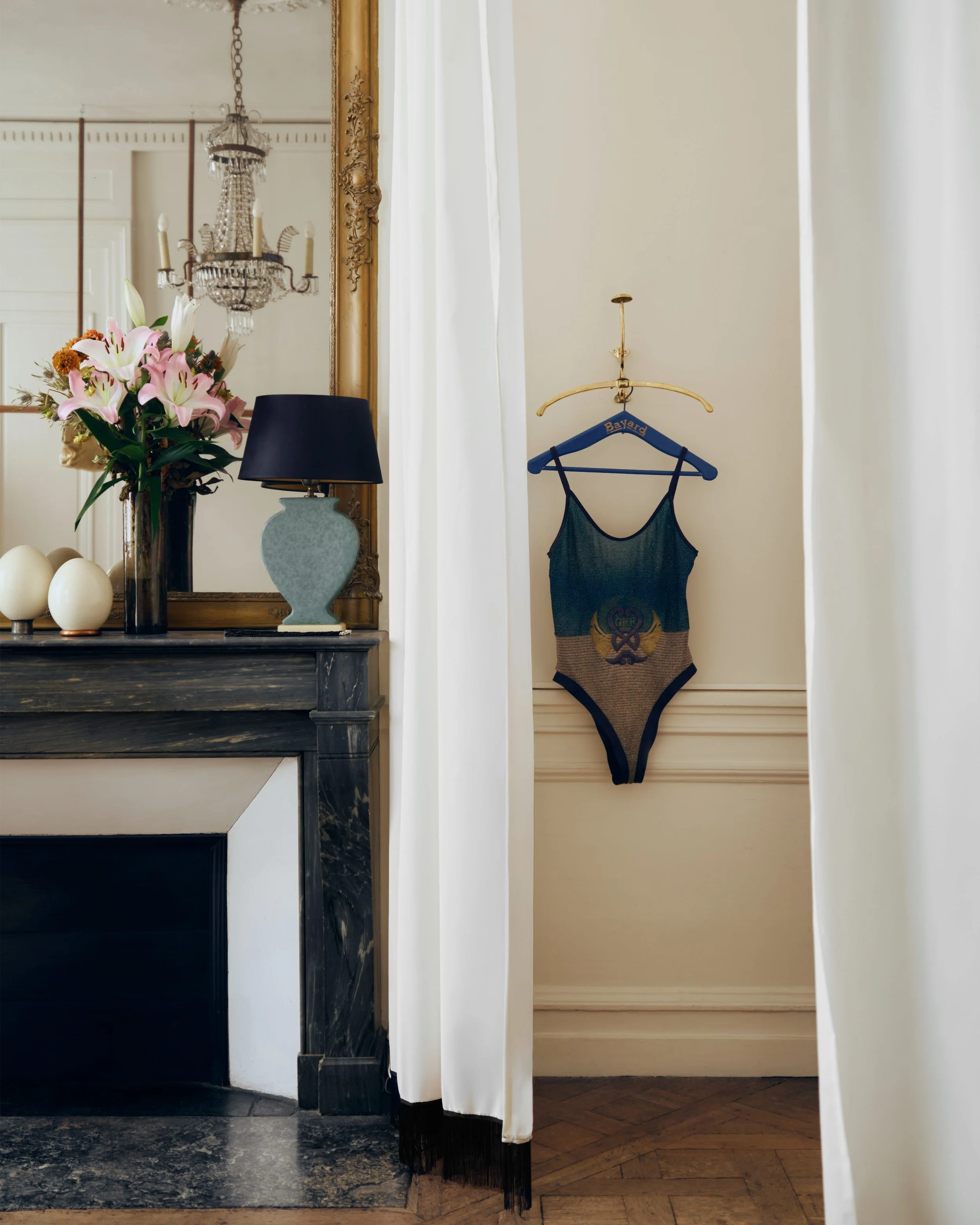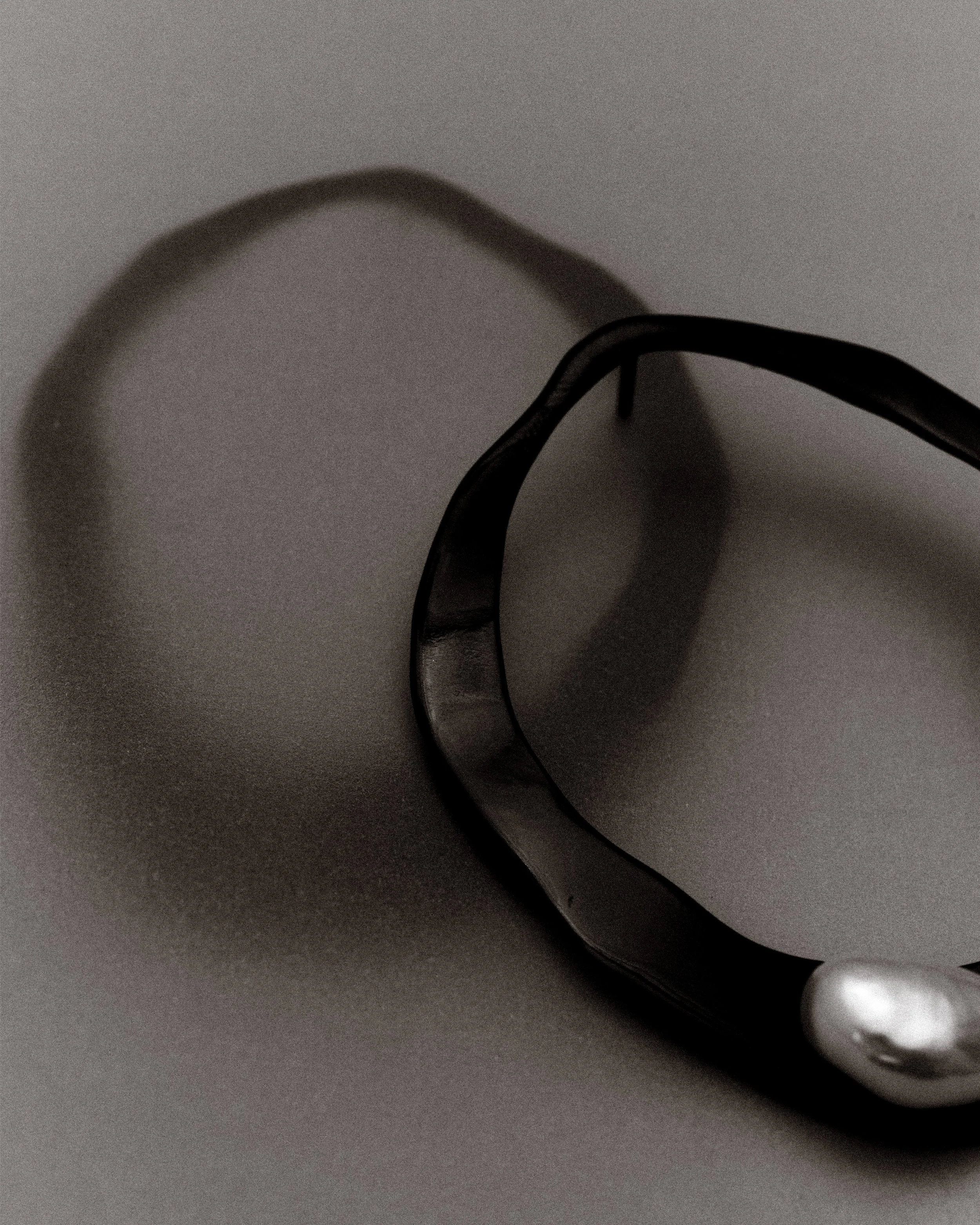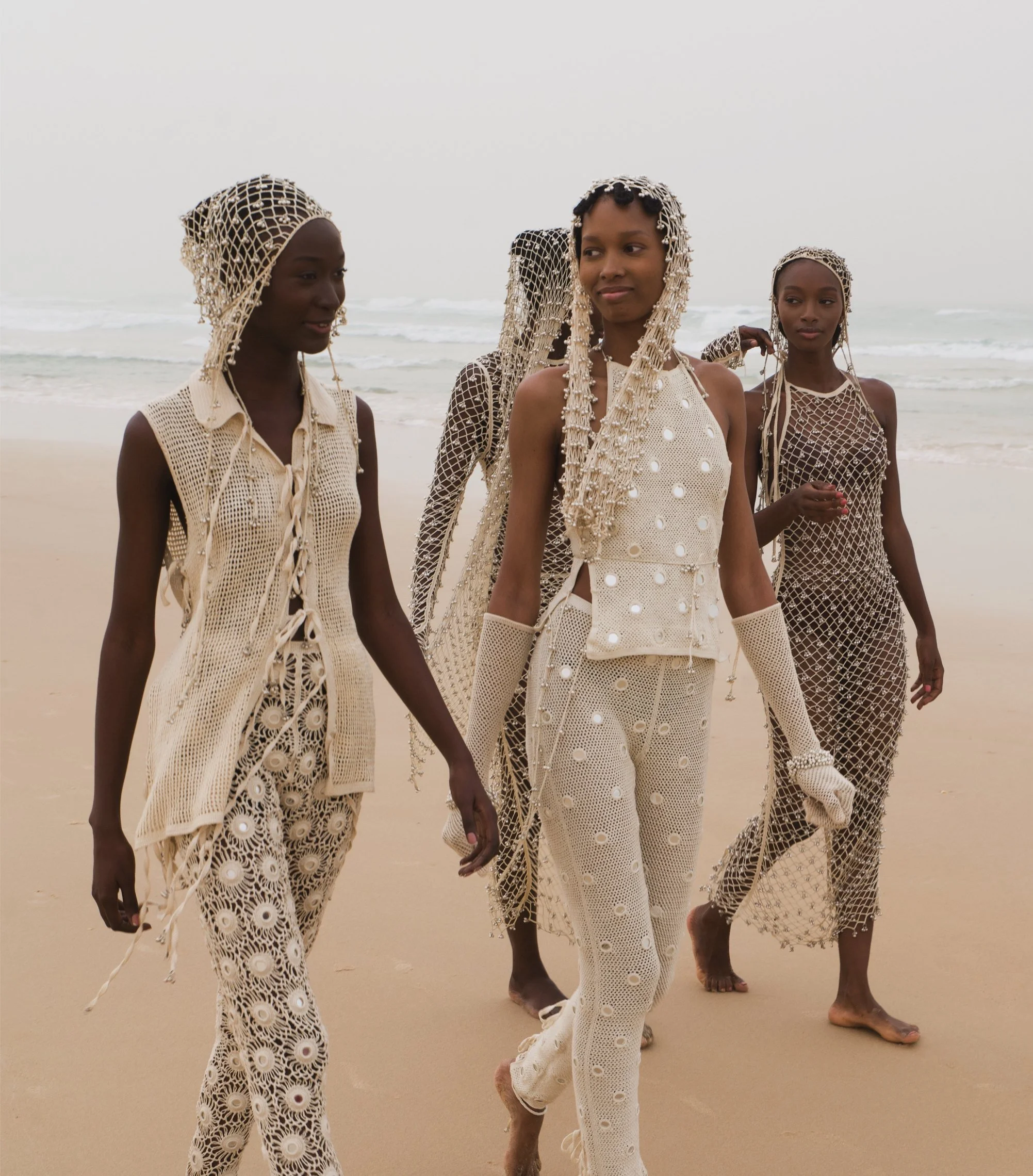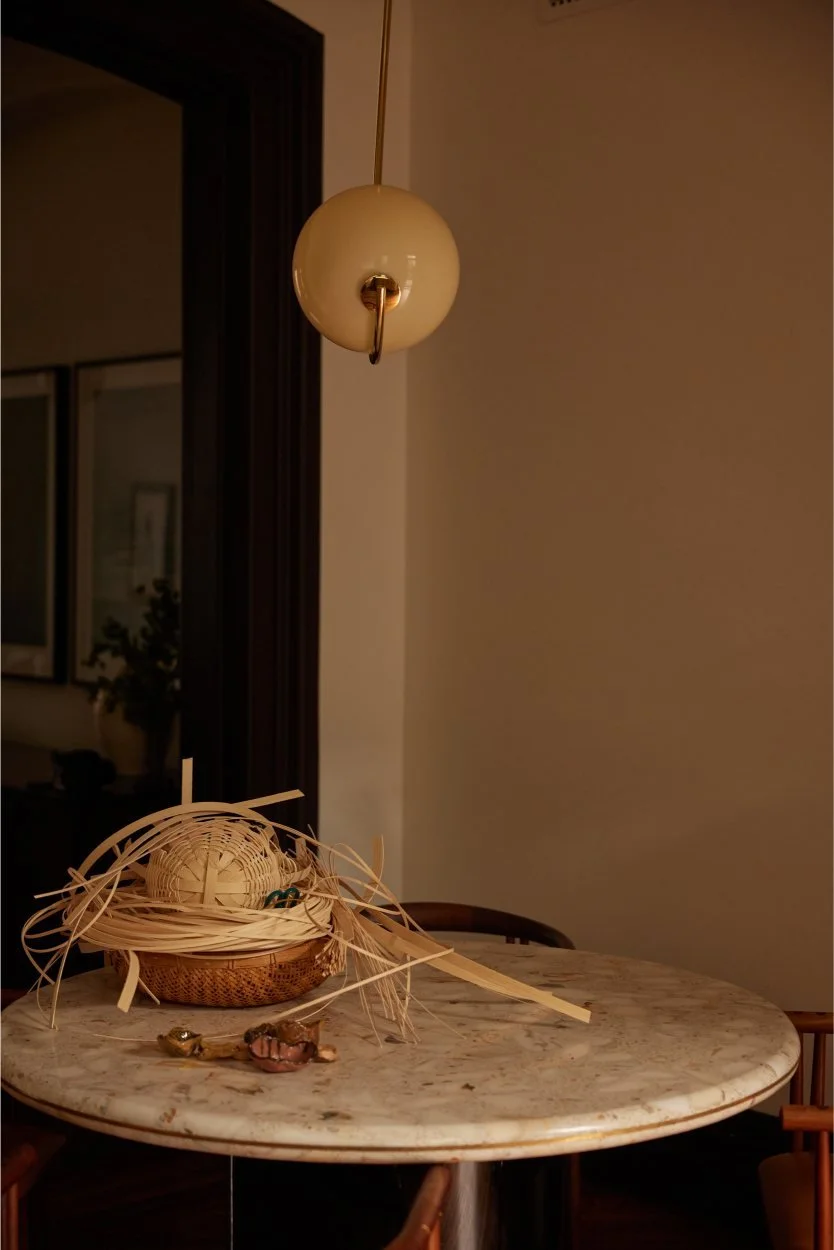Faroe Islands
Remote, raw and quietly magnetic, the Faroe Islands defy their size with landscapes and culture of striking depth.
In this piece, Ben Mulheran, Isabella Rose Davey and Tine Bek journey through a place where nature, tradition and creativity meet at the edge of the North Atlantic.
Words BEN MULHERAN, ISABELLA ROSE DAVEY and TINE BEK
Introduction NICOLE GAVRILLES
Photography TINE BEK
The Faroe Islands is a place of contrast and convergence. A place where land, sea, sky and cloud meet in a cluster of 18 islands that rise defiantly from the harsh and unpredictable conditions of the North Atlantic Ocean. A quick glance across the map might render the Faroe Islands as little more than some green flecks in a vast stretch of blue, but once you lay eyes on the imposing scenery and picturesque villages, this small nation reveals itself as rugged, delicate and completely enveloping. Here, waterfalls plunge straight into the sea, waves beat relentlessly against barren, windswept cliffs and green valleys soften the edges of an otherwise dramatic and atmospheric landscape.
Located equidistant between Scotland, Iceland and Norway, the Faroe Islands’ relative isolation has bred an enduring culture. For centuries it has marched on, unperturbed by the influence of mainland Europe’s cultural ebbs and flows, with only the rhythm of the wind and sea shaping its idiosyncratic language, food, art and culture. But an influx of creative ideas, forged on experimentation is sweeping across the Faroe Islands, welcoming new ideas that meld with the past to form bold new expressions of identity. Whether immersing yourself in nature’s solitude or exploring the thriving fashion and arts scenes, the Faroe Islands will surprise, inspire and surpass all expectations.
With so much on offer it can be hard to know where to start, so we suggest the most obvious – nature. And where better to begin than the iconic Múlafossur Waterfall, a dramatic cascade that plunges from a grassy cliff directly into the wild Atlantic Ocean. Set against the backdrop of tiny village of Gásadalur and the towering peaks of Eysturtindur to the east and Árnafjall to the north, it’s a scene so strikingly cinematic it almost feels surreal.
Travelling north to the island of Streymoy, you’ll find the remote village of Saksun, hidden out of sight from the main road, but well and truly worth the detour. Home to more waterfalls than permanent residents, Saksun’s natural beauty feels almost untouched by time. Nestled in a narrow fjord, grass-roofed cottages gaze over a natural amphitheatre, while a serene tidal lagoon stretches out toward the sea. Here, the charm and comfort that nature brings are delivered with a compelling isolation and silence silence reigns, disturbed only by the sound of cascading water and seabirds wheeling and crying overhead.
Tjørnuvík, the northernmost village on Streymoy Island, is a place where time slows and nature takes centre stage. One of the Faroe Islands’ oldest settlements, its location between steep mountains ensures its almost permanently draped in mist, giving it an atmosphere both ancient and otherworldly. On clear days, the black sand beach offers unbeatable views of the iconic sea stacks Risin & Kellingin rising out of the North Atlantic and a short stroll up the eastern hillside rewards visitors with sweeping panoramas and view from ancient Viking graves. If you’re in the mood for adventure, you can reach can take the scenic trail over the mountains from Saksun, or follow a rugged route toward the spiky cliffs of Mount Mýlingur. The braver among us (or foolhardy, depending on your perspective) can even don a wetsuit and take to the seas to surf a gentle beach break – weather permitting.
“It’s a space where tradition meets experimentation and where the artistic spirit of the islands is constantly morphing into new, bold expressions.”
If the idea of exploring nature isn’t striking a chord, then Torshavn, the Faroese capital offers plenty in the way of homely indulgences and creature comforts. Although it bears the somewhat unfortunate title of cloudiest city in the world, its charm shines through in other ways. Colourful harbourside houses, cozy cafés, and world-class Nordic dining make Tórshavn a haven for those who prefer comfort over cliffs. Wander the narrow, grass-roofed lanes of the old town, explore the local arts scene, or warm up with a bowl of fish soup in one the town’s world renowned cosy restaurants.
In a small, unassuming studio set back from Tórshavn’s harbour, you’ll find Leirlist studio, where Guðrið Poulsen creates ceramics that feel intrinsically tied to the Faroese landscape. Her work is earthy and understated, drawing inspiration from the islands’ windswept cliffs, tidal pools, and the contrast of mist-covered, rolling hills. There’s a deep sense of place in her practice and a balance between the wild and the calm - the enduring and the fleeting.
A short stroll away you can step into Steinprent, a printmaking studio and gallery that has become a cultural cornerstone for the Faroese art scene. Housed in a former fish factory, its industrial bones have been softened by creativity and collaboration. Local and international artists alike are drawn to its presses, producing works that span the conceptual and the deeply personal. Inside, there is a pervasive quiet focus as lithographs are pulled, inks are rolled, and stories are etched onto stone. It’s a space where tradition meets experimentation and where the artistic spirit of the islands is constantly morphing into new, bold expressions.
“Set along a river that winds through the valley, this family-run mill is dedicated to revitalising Faroese wool as a valuable commodity, rather than letting it go to waste.”
Further afield in the town of Skopun, the Spinning Mill by the River hums with a different kind of creativity. There is an old expression in the Faroe Islands, “Ull er Føroya Gull,” (wool is the Faroese gold) which stems from a pre-industrial era when wool was a ubiquitous, yet highly resource that was processed in Faroese households. Set along a river that winds through the valley, this family-run mill is dedicated to revitalising Faroese wool as a valuable commodity, rather than letting it go to waste. Visitors can witness the journey from raw fleece to fine yarn, and browse garments that combine heritage with design. Here, in the rhythmic churn of the machines and the lanolin-rich scent of the wool, you feel a deference to the humble Faroese sheep and the important role they have played in shaping the modern day Faroe Islands.
No trip to the Faroe Islands would be complete without sampling some of the traditional culinary delicacies the country is known for. Shaped over centuries by the necessity of having food through a long, harsh winter, Faroese cuisine has developed around fermentation, preservation, and the full use of seasonal ingredients — a celebration of both ingenuity and survival.
From wind-dried lamb cured in open sheds called hjallur, to fermented fish aged in the salty sea air, the flavours of Faroese food can be challenging, but they are honest, utilitarian and shaped by history. Today, a new generation of chefs is reinterpreting these traditions with care and creativity, bridging the gap between past and present and creating a cuisine that is both long-established and boldly new.
That reverence, translated through a lens of modern minimalism, defines ROKS — a Michelin star standout in Tórshavn’s growing constellation of world-class dining. With Carlos Alberto Andrade leading as Head Chef, ROKS is a masterclass in contemporary Faroese cuisine, specialising in seafood with precision and flair. The menu reads like a love letter to the ocean: sea urchin, langoustine, and Greenlandic snow crab — each dish a delicate balance of texture and temperature, salt and smoke. Yet it’s never fussy. Instead, it’s grounded, hands-on experience that pays tribute to the fresh and high
Tucked into the heart of Tórshavn’s old town, Barbara Fish House is a beloved local gem that serves up some of the freshest seafood the Faroe Islands have to offer. Everything on the menu is sourced from the waters surrounding the 18 islands, ensuring a dining experience that’s as flavourful, seasonal, and undeniably fresh as possible. Tables often book out days in advance, but if you’re lucky, you might snag a walk-in spot and treat yourself to an unforgettable seafood feast. To avoid missing out, it’s well worth reserving ahead and arriving hungry.
For a more daring culinary experience, RAEST – another Michelin star restaurant - takes things in a challenging, but ultimately rewarding direction. Specialising in fermented Faroese food, RAEST (which in Faroese means partially fermented) leans into traditional preservation methods that predate refrigeration, including wind-dried lamb and fermented fish. This method of fermentation has long been used in the area - since the first Vikings arrived over a thousand years ago. It’s a visceral, sometimes provocative experience, but one that connects diners with the ingenuity of the islands’ history.
And while Michelin stars and fine dining have their place, there’s something equally special about a bowl of fish soup at Fiskastykkið, a tiny eatery in the village of Sandavágur. Run by locals with a deep love for both food and hospitality, Fiskastykkið’s simple, creamy and fragrant wonder, flecked with herbs and generous chunks of fresh-caught fish. Served with a view of the fjord and the playful seals that call it home, Fiskastykkið’s fish soup is bound to warm you in even the darkest and frostiest Faroese winter.
The Faroe Islands don’t scream for your attention. They don’t need to. They wait quietly with their charm, wonder and beauty on full display for anyone who wants to come looking. And for those who do, the reward is a deep and lasting connection to a singular culture and landscape shaped by wind, water, and time. It’s not about ticking off landmarks or rushing through itineraries, but about letting the landscape unfold slowly around you. Here, meaning is found in inconspicuous moments. It may be the cry of a seabird, the slow movement of clouds above, or the warmth of a shared meal, the Faroe Islands are a place where it’s possible to be truly present.
Story published for ONE Magazine Online
YOU MIGHT ALSO LIKE

















We spoke with founder Erika Geraerts about her mission to challenge conventional beauty narratives through thoughtful design, transparent storytelling, and fewer-but-better products.